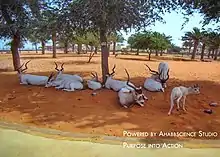Dubai Safari Park
Dubai Safari Park (Arabic: حَدِيْقَة سَفَارِي دُبَي, romanized: Ḥadīqat Safārī Dubay) is an eco-friendly[1] safari park[2] located in Dubai, United Arab Emirates. The park's major source of energy is solar energy. The Park is located on Al Warqa 5 on the Hatta Road. The park has 2,500 animals from more than 250 species.[3][4] The park replaced the Dubai Zoo on its 50th anniversary.[5] The park plans to increase the animal number to 5000 by 2020. On May 15, 2018, the Park closed for renovations and improvements until being reopened in October 2020.[6][7]
 | |
| Location | Dubai, United Arab Emirates |
|---|---|
| Coordinates | |
| Theme | Safari |
| Operated by | Dubai Municipality |
| Opened | December 12, 2017 |
| Previous names | Dubai Zoo |
| Area | 12.8 million Square feet |
| Website | www |
| Status | Operating |
History
The old Dubai zoo was replaced to Dubai Safari Park when It only had a collection of 1000 animals. The park consist of 12.8 Million square feet of area.[8] The old park had faced criticism internationally about the conditions the animals were kept in: Caged up, very little space, barely able to move. It was obvious that there had to be a much larger, more open, more modern habitat for the animals. Keeping in mind the tourism increase in Dubai, the municipality took a decision of increasing and moderating the Dubai zoo. $40.8 million where allocated to the project. The Project was given to Meraas, a UAE conglomerate. Parques Reunidos is hired as operation manager. The Park was opened on 12 December 2017, but closed for renovations and improvements in May 2018.[6]
Villages

The Park have major five Areas named as Safari village, Arabian Village, Asian Village, African Village and Wadi Village.[9]
Safari Village
Safari village is an open area where visitors can go by bus and have an amazing close encounter with animals including giraffes, lions and tigers.
Arabian Village
Spanning over 60,000 square meters, the Arabian Village is a dedicated to observe and learn about the native wildlife, like the Arabian oryx and wolf.[10] This area is designed containing the mountains, deserts, flowers and plants.
Asian Village
Animals from Asia are part of this village, including the Komodo dragon and Indian elephant.[11]
African Village
Here are kept the white lion and African wild dog.
Wadi Village
This is an area for relaxation. The area is created for relaxation after the long safari visit. The ground is lush green while there is ponds of fishes where you can watch fishes or waterfalls.
Kids Farm
It is a newly created section with a view kept in mind of learning for children.
See also
References
- "Mohammed bin Rashid visits AED 1.25 bn Dubai Safari Park". Arabian Business. 25 December 2017. Retrieved 30 December 2017.
- "Mohammad tours Dubai Safari Park". WAM. Gulf News. 24 December 2017. Retrieved 30 December 2017.
- "Sheikh Mohammed takes a tour of Dubai Safari". whatson.ae. Retrieved 30 December 2017.
- Nick Webster (12 December 2017). "First look inside the walls of Dh1 billion Dubai Safari". The National. Retrieved 31 December 2017.
- Sajila Saseendran (13 December 2017). "Two weeks of free entry to Dubai Safari". Gulf News. Retrieved 30 December 2017.
- "Dubai Safari park to close on May 15". Khaleej Times. 13 May 2018. Retrieved 10 October 2018.
- "Dubai Safari reopens with a wide range of new adventures after two years". gulfnews.com. Retrieved 22 November 2020.
- "Dubai Safari Park to reopen with new animals, adventures". gulfnews.com. Retrieved 13 June 2019.
- "Dubai Safari Park". www.dubaisafari.ae. Retrieved 10 October 2018.
- "Dubai Safari – everything you need to know". Time Out Dubai. Retrieved 28 November 2018.
- "Dubai Safari gets new wildlife additions". The National. Retrieved 13 June 2019.